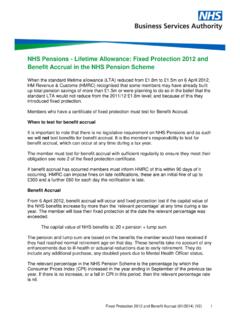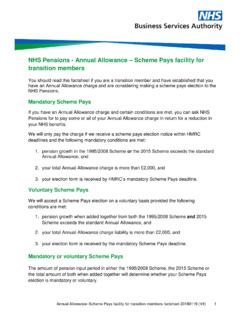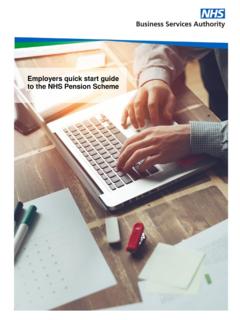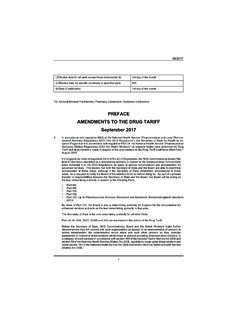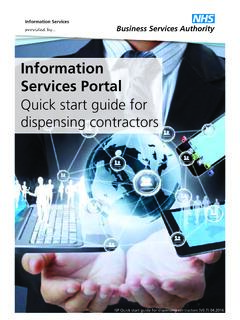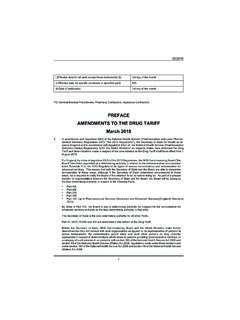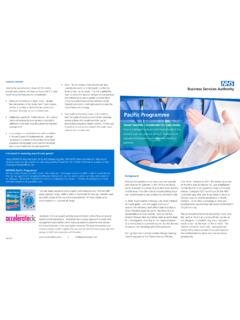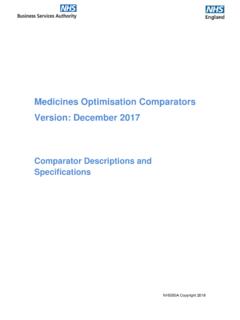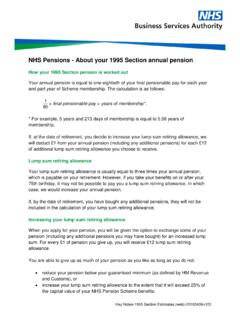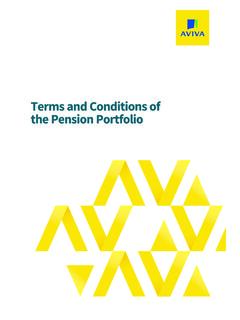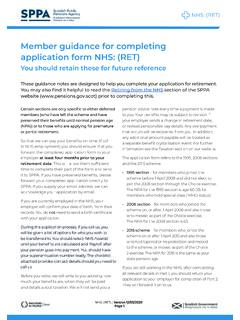Transcription of NHS Pensions - About your 2008 Section annual pension
1 Key Notes-2008 Section Estimates (web)-20210419-(V3) NHS Pensions - About your 2008 Section annual pension How your 2008 Section pension is worked out Your annual pension is equal to one-sixtieth of your reckonable pay (see below) for each year and part year of Scheme membership. The calculation is as follows: 601 reckonable pay years of membership*. *For example, 5 years and 213 days of membership is equal to years of membership. If, at the date of retirement, you decide to give up some of your pension to provide a lump sum retiring allowance, we will deduct 1 from your annual pension (including any additional Pensions ) for each 12 of lump sum retiring allowance you choose to receive.
2 If you chose to move to the 2008 Section of the NHS pension Scheme under the Choice exercise, when you retire, you must take at least the same amount of lump sum retiring allowance that you had earned at 31 March 2008 in the 1995 Section . This mandatory lump sum is paid for by reducing your pension by 1 for every 12 of lump sum that you take and was explained in the Choice statement we sent to you. If, by the date of retirement, you have bought any additional Pensions , they will not be included in the calculation of your mandatory lump sum retiring allowance. Part of your annual pension will be increased for each complete month you work after reaching age 65 years if you are an active member of the Scheme.
3 Optional lump sum retiring allowance When you apply for your pension , you will be given the option to exchange some of your pension (including any additional Pensions you may have bought) for a lump sum or (if you chose to move to the 2008 Section of the NHS pension Scheme under the Choice exercise) of increasing your mandatory lump sum, by exchanging some of your pension (including any additional Pensions you may have bought). For every 1 of pension you give up, you will receive 12 lump sum retiring allowance. Key Notes-2008 Section Estimates (web)-20210419-(V3) You are able to give up as much of your pension as you like as long as you do not: reduce your pension below your guaranteed minimum (as defined by HM Revenue and Customs), or increase your lump sum retiring allowance to the extent that it will exceed 25% of the capital value of your NHS pension Scheme benefits.
4 For the purposes of illustration, we have worked out your pension benefits assuming you chose to: have no lump sum retiring allowance, and take the maximum amount of lump sum retiring allowance possible. If you chose to move your 1995 Section benefits to the 2008 Section we have worked out two sets of pension benefits by assuming that you choose to: take your mandatory lump sum retiring allowance only, and take the maximum amount of lump sum retiring allowance possible. You do not have to give up any pension at all, but to help with planning a calculator is available on our website. It will enable you to use the information from the enclosed pension estimate to look at different lump sum options , if you decide to give up a smaller part of your pension .
5 It is important to understand that any figures you obtain from the calculator will be provided for the purpose of illustration only. They will give an indication of what you might get, but the final benefits may vary depending on changes in your personal circumstances and to the rules of the pension scheme. You should consider seeking independent professional financial advice before making any decisions. Any lump sum retiring allowance is normally payable on your retirement. Maximum lump sum HMRC has restrictions on the amount of tax free pension commencement lump sum (PCLS) paid by a pension scheme, unless the individual has a protected lump sum or other types of protection.
6 The PCLS is the lower of: 25% of the capital value of the benefits to be paid (after the exchange of pension for lump sum and not the basic amounts), or 25% of the available standard Lifetime Allowance (LTA). The actual amount of tax free lump sum available at retirement will depend on your individual circumstances and may be: Key Notes-2008 Section Estimates (web)-20210419-(V3) 1. higher than the current maximum possible tax free PCLS if you hold certain types of protection or have a protected lump sum from HMRC, or 2. lower than the current maximum possible tax free PCLS if you already have benefits in payment (either from the NHS pension Scheme or another pension provider) which reduces their available LTA.
7 If the maximum lump sum after commutation exceeds 1 above, then not all the lump sum may be tax free. More detailed information About maximum lump sums and tax can be found on our website. Your reckonable pay For estimation purposes, your reckonable pay is calculated using the average of the best consecutive three years in the last 10 (or, if less, the amount of time you have been in the 2008 Section of the NHS pension Scheme). Before selecting the best consecutive three years pay, each year in the last ten will first be revalued in line with the Consumer Price Index (CPI). This may result in an earlier three year period providing the reckonable pay to work out your pension benefits.
8 If you have moved from the 1995 Section to the 2008 Section under the Choice exercise, only pensionable earnings from 1 April 2008 up to your last day of membership are taken into account. If you work part time, we calculate your reckonable pay as if you were full time. Protected pay This estimate shows your current reckonable pay, but if you have one or more periods of deferred or protected membership, we calculate your pension using the most beneficial of the following two methods: Calculating a pension for each period of membership using the reckonable pay earned in that period, and adding the Pensions up, or Calculating your pension using your reckonable pay at retirement for all periods of membership.
9 Normal pension age The normal pension age for members of the 2008 Section is age 65. Key Notes-2008 Section Estimates (web)-20210419-(V3) Your membership If you work full time, you build up one day s membership for each day you are a member of the Scheme. If you work part time, the membership you build up is proportional to the hours or sessions you work when compared with the whole time equivalent hours or sessions. For estimation purposes, we have assumed that your current membership pattern is maintained up to the date of retirement. If you chose to move to the 2008 Section under the Choice exercise, the membership you have built up to 31 March 2008 may be reduced if you were over age 60 at 1 October 2009.
10 If your membership is subject to a reduction the amount you built up to 31 March 2008 is reduced before being used to calculate your annual pension . This was explained in more detail on the Choice statement you received at the time you elected to move. Increasing your membership Your membership may be increased if, by the date of retirement: you transferred your pension rights from another scheme into the NHS pension Scheme, or you bought additional membership as a member of the 1995 Section you retire because of ill health. Limiting your membership You are allowed to build up membership up to a total limit of 45 years pensionable membership at calendar length. If you achieve 45 years pensionable membership and continue in NHS employment you can, if you wish, continue to pay contributions into the Scheme.
